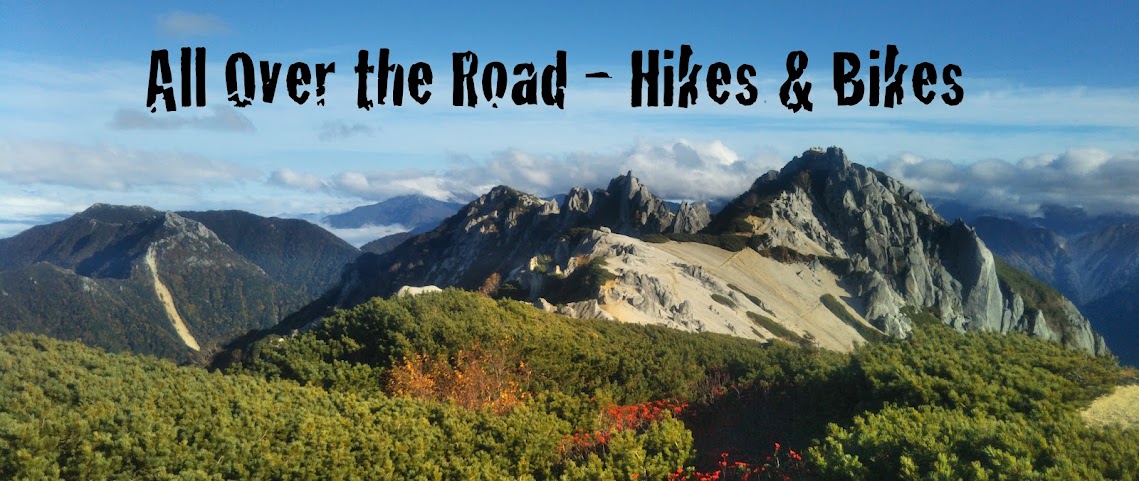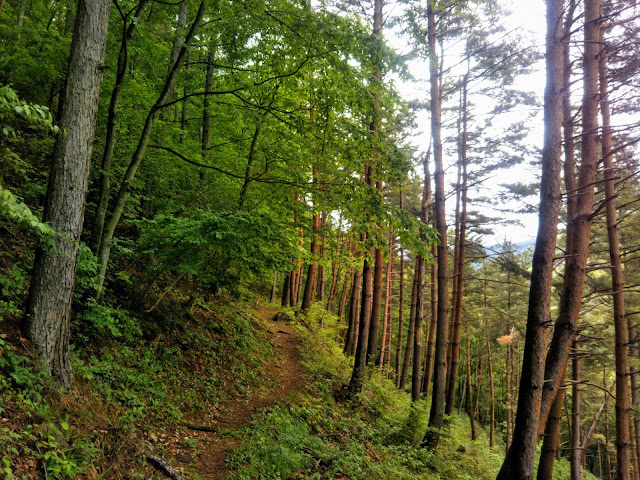The ride from my house to the trailhead wasn’t particularly
challenging: three hundred meters of vertical (that’s almost a thousand feet
for you Americans) over twelve kilometers of road. (Forty thousand feet, please
learn the metric system, people!)
Granted, it wasn’t as easy as it could have been. I had to
take my cheesy foldable bicycle with the twenty-inch wheels because Yeti, the
road bike that has taken me across Alaska, Japan, Malaysia, Thailand, Cambodia,
Laos and Vietnam, is now sitting around refusing to fix itself.
My goal was Eboshi-iwa, a tall skinny tower of rock that
makes for a fine excuse to go hiking in the hours between fatherly responsibilities.
I’d been there before, albeit by a different route, so I knew nothing of the
length or the terrain of the trail I’d be taking today. I wasn’t even sure
there was a trail; last year, in a moment of gracious insanity, I lent my primo
trail map of this area to my wife’s friend, Ryoko.
I haven’t seen Ryoko or my map since.
I was about a kilometer (figure it out yourself) from the
trailhead when my back tire went flat. I didn’t have a patch kit, or a spare
tube or an air pump because I generally don’t bother to prepare for such
occasional contingencies. I’m too busy trying to get out of the house before
someone can ask me to do something else for them. Besides, this bicycle had
been operating perfectly for the almost four years since I rode it home from
the garbage heap at the collection site down the street. It’s unbelievable the
things people will just throw away. (Bringing home a discarded bike; maybe this
is why Yeti is pouting in the shed.)
Aside from being unprepared, I also tend to travel light. I
don’t like hauling around unnecessary bulk – like extra sneakers – so I had
nothing but the hiking boots already on my feet as I began running (a generous
term) with my bike up the road. It wasn’t until I finally found the trailhead
that I knew how long the trail to Eboshi-iwa was. And I still didn’t know the
terrain. But no matter. I could worry about the time – and that flat tire –
later.
I locked my bike and took off clomping down the trail - or maybe someone's driveway.
.
A minute later I stopped.
Two gates before me. I had to choose. It felt like a game
show.
I won! And on down the hill my boots clomped.
To this point the trail resembled a rutted access road.
Probably because it was. Door Number Two took me down a path of dirt, then
gravel, then concrete that crossed a stream and rose sharply before turning
into a crumbling mix of all three. A sign for Eboshi-iwa pointed me left,
bringing me up a dirt path that soon morphed into a lush, level ribbon of grass.
This soon gave way to more dirt.
Swaths of grass can be hard to come by on a school
playground in Japan, never mind on the side of a mountain. Rock walls are more
prevalent out here, though as remnants of centuries-old castles and such. And
I’d never seen or heard of any old fortress ruins out here.
I have noticed an increase in signs on some of the trails in
this area, in many cases the new ones replacing the old, weather-beaten ones.
Here, however, were two signs for Eboshi-iwa pointing in two opposite
directions. Neither sign looked very old. One of had only Japanese characters.
The other had “Eboshi-iwa” in English lettering as well as Japanese. I suspect this
was an attempt by someone to keep the invading foreigners out of certain areas
now that the castle walls are mostly in ruins.
With my primo map of the area gone right along with Ryoko, I’d
had to resort to a third-grade level download of these trails. The path leading
left, marked by the Japanese-only sign, was on my digital navigator missing a
chunk in the middle. Whether this was meant to dissuade people from hiking up a
trail that had fallen into disrepair or was another part of someone’s
Keep-the-Foreigners-Out scheme I couldn’t say.
If the clock wasn’t ticking I might have gone left.
As the path wound and rose the ground underfoot slowly shed
its multiple personality disorder. Eventually the evidence of the ongoing
deadwood removal work was the only thing interrupting the consistency of the rolling
dirt trail. The fresh, bilingual signs kept coming, assuring me I was on the
right path – or should I say the path someone wanted me to stay on. The signs
appeared with an almost irritating frequency, actually. Every few hundred
meters I was reminded how far I still had to go, which in turn reminded me that
I had twelve kilometers to cover on a flat tire once I was back down off the
mountain and out of the woods.
At an apparent fork in the trail the forest turned suddenly,
suspiciously disheveled. All over the uneven ground fallen branches and leaves that
somehow seemed imported lie strewn like the aftermath of an intemperate storm. Sitting low in the midst of the contrived disaster scene was a rock
sporting two characters, for “stop” and “mountain”. They were bright orange and
arguably hastily-painted, and together made no sense to me. Stop the mountain? Stop! Mountain! The rock’s odd placement on the ground didn’t help in
discerning what the grizzled elf sprite that did this was trying to say.
Either someone really doesn’t want me here, or wants me lost
out here forever.
Despite the suspect nature of the man-made bits, Nature
remains beautiful.
Meanwhile the Shinto-infused evidence of man’s infliction on
the land remains magically, beautifully harmonious. Traditional Shinto deifies
all aspects of Nature, and the expression of Shinto (“The Way of the Gods”)
manages to enhance rather than detract from that to which it ascribes its
spirit.
And though I may harp on man’s other intrusions, I do
appreciate the signs.
The name Eboshi-iwa literally translates as “Crow’s Hat Rock”
though it comes with the added meaning of “nobleman’s headgear”. Viewed from
certain angles and mixed with a touch of imagination the name seems like it could fit.
Though if I saw someone walking around with a hat shaped like that? Noble probably wouldn't be the first word to come to mind.
For some, Eboshi-iwa means a chance to test their rock-climbing skills. That’s
fine I guess, although judging from the gear left behind on top of the crow’s
hat they might want to also practice their cleaning-up-after-themselves skills.
On a clear day the view from the rocks that sit slightly
above Eboshi-iwa is fantastic, if limited to the southern half of the surrounding
mountain landscape. Even under less than perfect skies this is still a great
place to feel above the gentle crush of the everyday.
The hike up there and back down ended up taking less time than I’d allowed
for. So did the trek home as I decided, after twenty minutes of running with my
bike along the side of the road, to jump on and roll downhill, daring that flat
tire to turn to powdered rubber from the grinding pressure of steel bike wheel and pavement. After four years it had become pretty worn, it needed to be replaced
anyway. Plus it would be fun, I thought, to see how absolutely shredded it
would get over the next ten kilometers.
To my amazement, it not only survived, it remained usable,
if barely. The tube inside should have been torn to ribbons, but upon
inspection I found only the original single pinhole that had almost destroyed
the day.
I patched it up with some expired glue and a dried-out bit of rubber from the
shed. The next day I found the patch had held.
I guess there are some people out there – sign makers and
tire patch manufacturers among them – who want us to be able to keep on exploring.
I’d say it’s only right to oblige.




















No comments:
Post a Comment